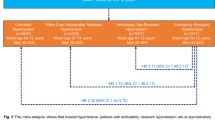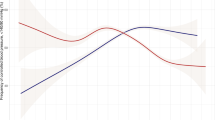Abstract
We report a retrospective longitudinal observational study of co-morbidities and medical events associated with initiations and changes in antihypertensive therapy in 475 hypertensive patients of a large general practice. The median follow-up time was 7.0 years for males and 7.2 years for females. The data showed a low frequency of appropriate lifestyle recommendations (<30%), a gender-bias in lifestyle recommendations against women and that more than half of all patients’ blood pressure (BP) was uncontrolled when last seen. Nearly half of all patients had co-morbidities relevant to essential hypertension (EHT) at first treatment for EHT and more than 11% of patients had more than one such co-morbidity. Whilst there was an increase in usage of ACE inhibitors and calcium channel blockers (CCB) as first treatment for EHT, there was also evidence that the existence of relevant co-morbidities rationally accounted for the majority of that increase. There were 5176 medical events relevant to EHT associated with change of drug or dosage treatment of EHT and the study provided evidence that the occurrence of such relevant medical events can rationally account for the majority of changes to EHT treatment. The study suggests that whilst general practitioners may fail to promote lifestyle changes to their patients with EHT, there is evidence that, when examined in sufficient detail, general practitioners’ decisions to initiate changes in antihypertensive therapy are in keeping with the evidence base.
This is a preview of subscription content, access via your institution
Access options
Subscribe to this journal
Receive 12 digital issues and online access to articles
$119.00 per year
only $9.92 per issue
Buy this article
- Purchase on Springer Link
- Instant access to full article PDF
Prices may be subject to local taxes which are calculated during checkout
Similar content being viewed by others

References
The management of hypertension: a consensus statement Australian Consensus Conference 1993 Med J Aust 1994 160 (Suppl) S1–S16
1999 World Health Organization-International Society of Hypertension Guidelines for the Management of Hypertension Guidelines Subcommittee J Hypertens 1999 17 151–183
Hoey J The one and only Mrs. Jones [editorial; comment] CMAJ 1998 159 241–242
Horton R The grammar of interpretive medicine CMAJ 1998 158 245–249
Bowling A Research methods in health: investigating health and health services Philadelphia Open University Press: Buckingham 1997
Bridges-Webb C et alMorbidity and treatment in general practice in Australia 1990–1991 Med J Aust 1992 157 (Suppl) S1–S57
Acknowledgements
This study was supported by a grant from ASTRA Pharmaceuticals, North Ryde, NSW, Australia. We gratefully acknowledge the assistance of our staff: Julie Clifford, Katherine Dudzynski, Wendy Newbury and Carol Holst.
Author information
Authors and Affiliations
Rights and permissions
About this article
Cite this article
Brokensha, G., Marley, J. An observational study of the medical events associated with clinician-initiated changes in treatment for essential hypertension. J Hum Hypertens 15, 381–385 (2001). https://doi.org/10.1038/sj.jhh.1001195
Received:
Revised:
Accepted:
Published:
Issue Date:
DOI: https://doi.org/10.1038/sj.jhh.1001195


